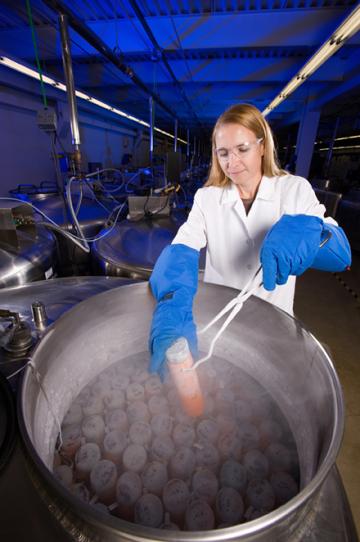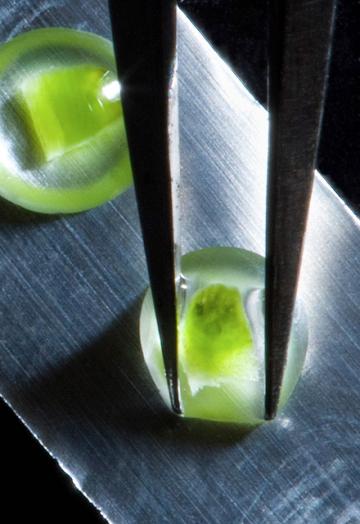A “Library” for Safeguarding Our Food Supply

ARS animal support scientist Carrie Wilson retrieves a goblet of animal germplasm samples from a liquid nitrogen tank where they are kept in long-term storage. Samples are stored at -196° C. (Peggy Greb, D3764-1)
It has concrete walls that could withstand a tornado, rooms kept at arctic temperatures, seeds that are 100 years old, and it is home to one of the longest running scientific studies in the world.
The National Laboratory for Genetic Resources Preservation (NLGRP) in Fort Collins, Colorado, houses the world’s largest collection of genetic resources gathered under one roof: material from 167 breeds of livestock (36 species) and material from more than 1.1 million cultivated, wild, and endangered plants from around the world
The USDA-ARS facility is both a resource for scientists and breeders and a back-up of our nation’s food supply – a kind of library for the genetic material that makes up our crop plants, their wild relatives, and the domesticated animals (and aquatic species) that we need to survive. It is widely considered a necessity because many of those plants and animals are threatened by emerging diseases, invasive pests, habitat loss, climate change, and in the case of livestock, illnesses and fertility problems.
The stored materials, known as “germplasm,” include the seed, pollen, and vegetative tissue (buds) of plants as well as the sperm, embryos, and tissues of animals. NLGRP is part of a national network of plant gene banks made up of material from animals and plants donated to ARS for safekeeping and study. NLGRP backs up the entire collection, securing materials for the long term, and as part of the network, it sends out animal samples, and in some cases plant samples, to researchers, breeders, and educators in the United States and overseas. Plant samples also are stored and sent out by other ARS gene banks in the network.

Citrus cultivars are preserved in liquid nitrogen at the ARS National Laboratory for Genetic Resources Preservation for long-term safekeeping. Here, a 1-millimeter citrus shoot tip is placed into a droplet of cryoprotectant solution on a foil strip. The strip will then be plunged into liquid nitrogen. (Peggy Greb, D3754-1)
Any new seeds patented in the United States are shipped for storage to the seed vault, which is secured with a combination lock that only a handful of employees can open. Samples, or “accessions,” are stored in cold vaults, or when necessary, in stainless steel, cryogenic tanks in which tissues are submerged or held in vapors of liquid nitrogen and frozen at sub-zero temperatures (-320 degrees Fahrenheit).
Over the years, NLGRP scientists have developed new methods for storing the germplasm to keep it viable for as long as possible, and their efforts often focus on addressing emerging threats. Recent achievements, for example, include finding new ways to cryopreserve budwood from the citrus trees that are being attacked by the Asian citrus psyllid. Another project focused on cryopreserving budwood from ash trees, which are being killed off by the emerald ash borer.
The collection includes donations made decades before the facility was built in 1958. In what is believed to be one of the world’s longest running plant studies, NLGRP scientists periodically evaluate the viability of seeds of a native California wildflower (Clarkia elegans) that were sealed up in vacuum tubes in 1948 to determine how long plant seeds can remain viable in storage. The tubes are being opened every few years at NLGRP. So far, at least some seeds in each tube have remained viable. Plans call for the tubes to be opened periodically until the year 2307. —By Dennis O’Brien, ARS Office of Communications.
You May Also Like















